
Photo from wikipedia
Quantifying individual variation in labile physiological or behavioral traits often involves repeated measures through time, so as to test for consistency of individual differences (often using repeatability, “R”) and/or individual… Click to show full abstract
Quantifying individual variation in labile physiological or behavioral traits often involves repeated measures through time, so as to test for consistency of individual differences (often using repeatability, “R”) and/or individual differences in trendlines over time. Another form of temporal change in behavior is temporal autocorrelation, which predicts observations taken closely together in time to be correlated, leading to nonrandom residuals about individual temporal trendlines. Temporal autocorrelation may result from slowly changing internal states (e.g., hormone or energy levels), leading to slowly changing behavior. Autocorrelation is a well-known phenomenon, but has been largely neglected by those studying individual variation in behavior. Here, we provide two worked examples which show substantial temporal autocorrelation (r > 0.4) is present in spontaneous activity rates of guppies (Poecilia reticulata) and house mice (Mus domesticus) in stable laboratory conditions, even after accounting for temporal plasticity of individuals. Second, we show that ignoring autocorrelation does bias estimates of R and temporal reaction norm variances upwards, both in our worked examples and in separate simulations. This bias occurs due to the misestimation of individual-specific means and slopes. Given the increasing use of technologies that generate behavioral and physiological data at high sampling rates, we can now study among- and within-individual changes in behavior in more detailed ways, including autocorrelation, which we discuss from biological and methodological perspectives and provide recommendations and annotated R code to help researchers implement these models on their data.
Journal Title: Behavioral Ecology
Year Published: 2019
Link to full text (if available)
Share on Social Media: Sign Up to like & get
recommendations!